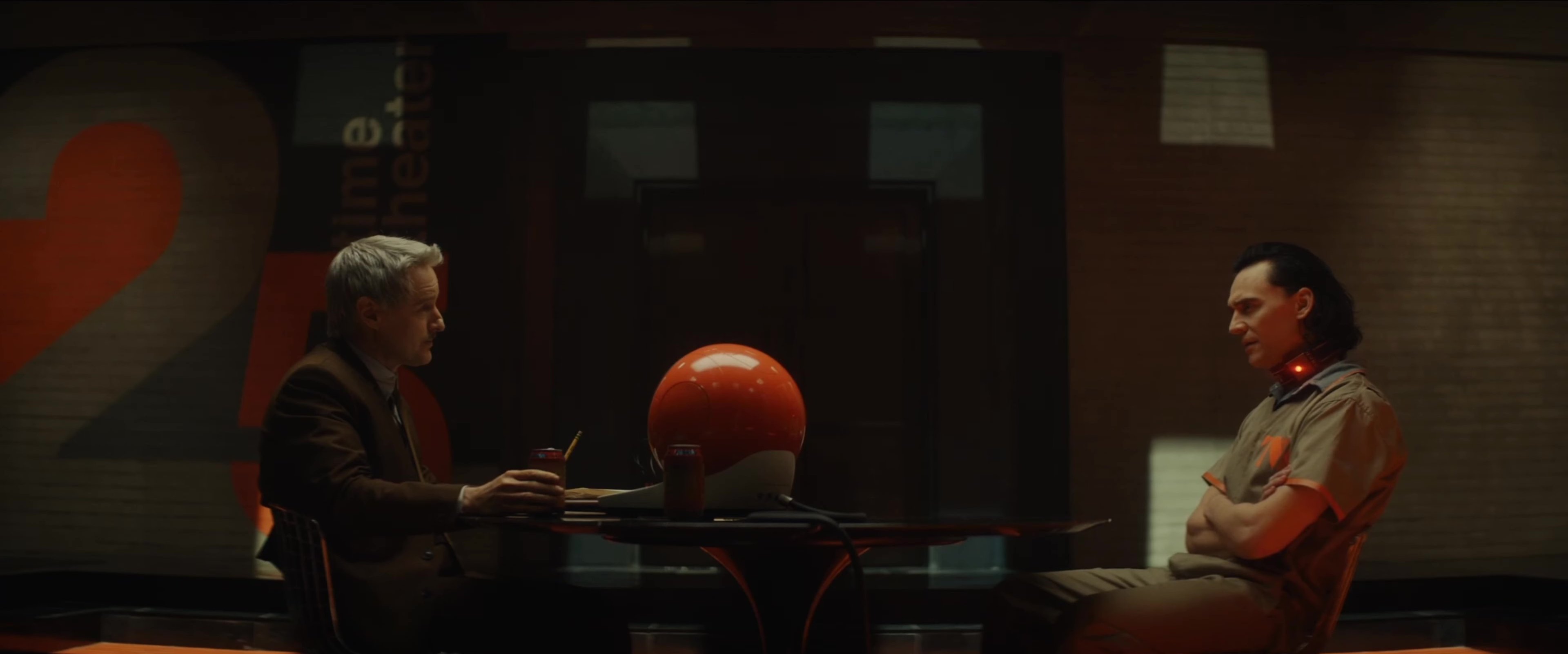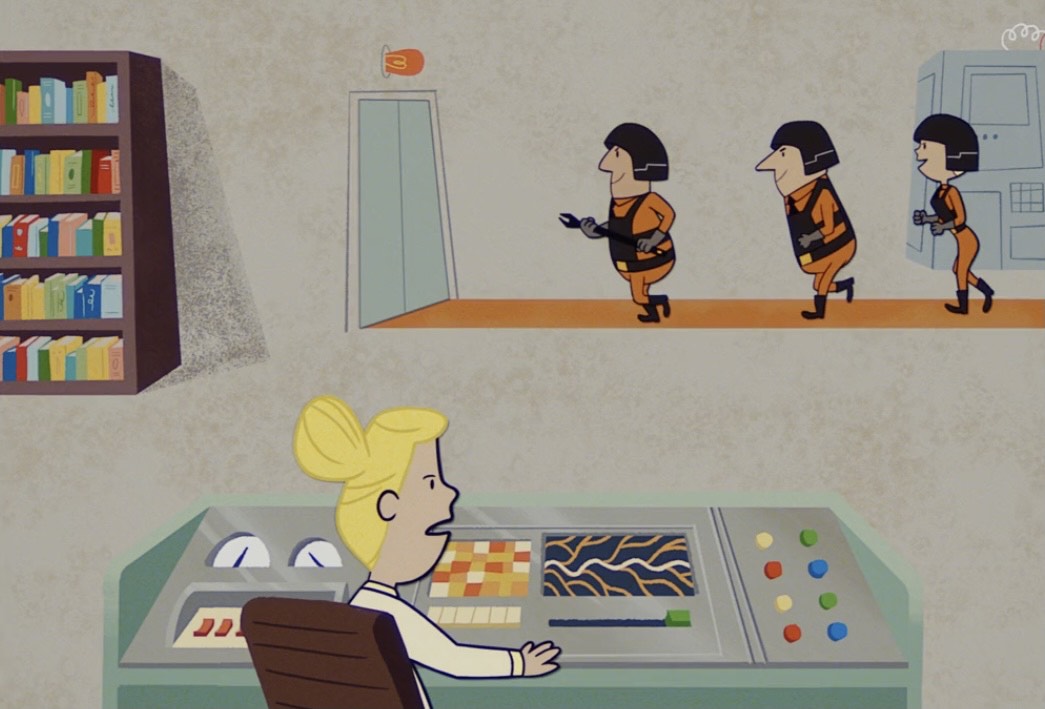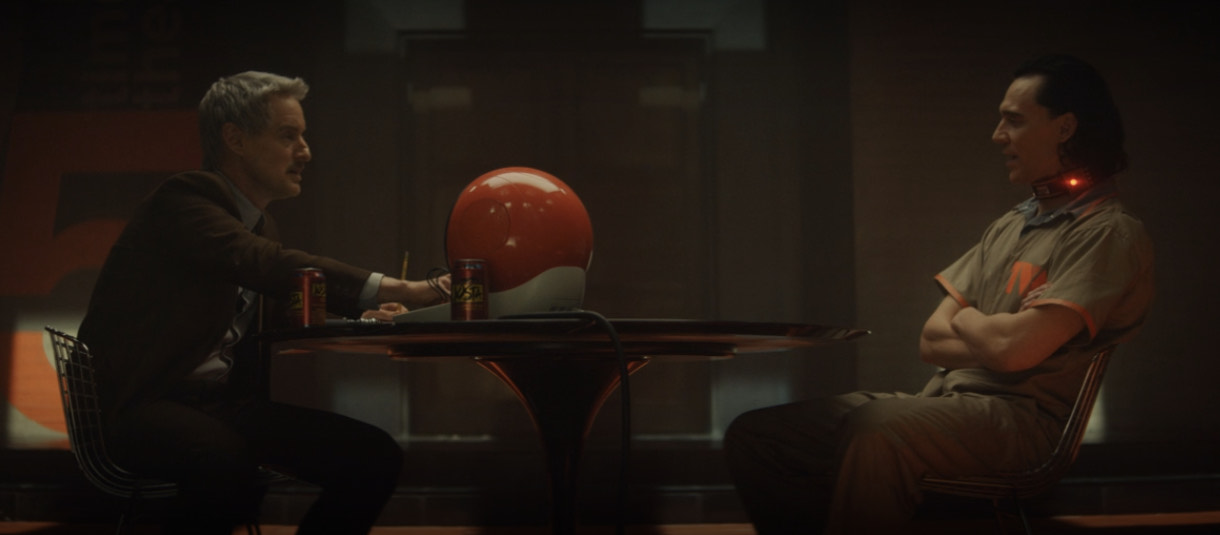'Loki' — breaking down the aesthetic of the TVA
The TVA follows a similar path to the timekeepers of 'The Umbrella Academy' and 'The Adjustment Bureau.'

This post contains spoilers for Loki.
Check out our spoiler free review for the first two episodes here.
The first few episodes of WandaVision took viewers on an interior design journey drawing upon familiar sitcom imagery made famous by The Dick Van Dyke Show, I Love Lucy, and Bewitched. Beginning in the 1950s, Wanda’s (Elizabeth Olsen) fantasy stretched into the 21st century until the real world couldn’t be kept out any longer. The switch from black and white to color at the end of Episode 2 played into the bold palette of television comedy as opposed to the more muted tones of The Falcon and the Winter Soldier. The second offering from Disney+ is more in line with the Marvel movies that take place on Earth (and in the present) and is visually less playful. Enter, Loki to inject more whimsy into the timeline, or rather into the Time Variance Authority.
The first episode of the new series opens with a familiar scene of Loki (Tom Hiddleston) making a getaway before he is captured and taken to this previously unseen agency. “What is this place?” is the first question he asks upon seeing the reception area dipped in a midcentury modern aesthetic. While this is also the first time the audience is getting a glimpse of the TVA, the office set-up and the era it emulates is similar to other sci-fi stories that feature a bureaucracy tasked with ensuring the past, present, and future is not altered. Time travel has different rules and parameters depending on the narrative, but this particular interior design reference is a trend that features in Loki, The Umbrella Academy, and The Adjustment Bureau. Why are timekeepers such sticklers for vintage surroundings?
To dictate the proper flow of time in Loki, a system that extracts figures who have taken a wrong turn is implemented, and the impish God has strayed from his intended path. It isn’t a case of anyone who time travels will have to face Rovanna Renslayer (Gugu Mbatha-Raw) because otherwise, this courtroom would be rather crowded. However, Loki’s choice to pick up the Tesseract in 2012 has landed him in deep water that requires a Miss Minutes (Tara Strong) explainer behind his incarceration. This animation is an effective exposition tool through the guise of retro PSA that introduces the TVA clock mascot and the rules of this world.
Before Loki has entered the queue system — that will fill anyone who has stood in line in a drab building like this with dread — he gets an outfit change via a robot. His green and gold Asgard robes don’t fit the mix of muted office attire and tactical garments. Instead, he wears prison-type garments in the signature TVA colors bearing the logo of this organization. On the whole, most of what we see in the TVA is made up of retro-futuristic tech that never caught on and design features that would now be considered a nostalgia-infused purchase. It is the ‘50s and ‘60s distilled into a popular orange and grey palette from that era — though typically orange was paired with brown and grey with chartreuse. Production designer Kasra Farahani has created an environment that matches the plastic, wood panel, patterned, and curved shapes that dominated. This time-warp quality makes this place feel otherworldly, particularly when coupled with the cityscape visual and flying cars straight out of a 1950s sci-fi adventure.

Leaning into retro visuals is often shorthand to enhance an off-kilter vibe whether it is the Chilling Adventures of Sabrina’s town that resembles the period of the original comic book setting or The Umbrella Academy’s Grace Kelly-mimicking robot mother figure and time travel briefcases. The latter is how those who work for the Temps Commission bounce from year to year, and this organization’s base is in 1955. This date is infused through a series of costumes by Christopher Hargadon that wouldn’t look out of place in a Hitchcock thriller and the headquarters are awash with oddities. Much like the TVA, the Temps Commission is tasked with watching over the space-time continuum and ensuring certain events go ahead — the second season is built around the assassination of JFK. The older version of Number Five is dressed in a fedora and suit when he arrives in Dallas on that fateful 1963 date. It is a fairly standard outfit choice for the period and also resembles the timeless attire worn by the timeline guardians in The Adjustment Bureau.
Anthony Mackie and John Slattery — who Owen Wilson bears a resemblance to in Loki — are two members of the titular Adjustment Bureau who find themselves dealing with a human who strays from his path. This 2011 sci-fi romance is an adaptation of Philip K. Dick’s short story “Adjustment Team” that features a mysterious group of men charged with making sure “the Plan” is not deviated from. In this case, Matt Damon plays a congressman who has a chance meet-cute that derails this sacred document. Whereas Number Five’s suited look matched the prevalent 1960s trend, the hat-wearing men in The Adjustment Bureau are a sartorial throwback to a New York City of the past. The suits and double-breasted coats are classic, but office-ready hats are far less ubiquitous on men in the 21st century. Dick’s short story was first published in 1954 and this was a period of great innovation and imagination for what might come. Perhaps the desire to dream big coupled with shadowy government developments during the Atomic Age means we associate this era with a power that controls destiny.
The latest updates, reviews and unmissable series to watch and more!

Another potential motive behind choosing a design path that shares elements of Vision’s (Paul Bettany) workplace in the first few episodes of WandaVision is that it represents the classic American office and what could be more ordinary than that? Science fiction is predicated on taking the familiar and making a few tweaks that disrupt or innovate. In this case, the sacred timeline is put in the hands of men who look like they would normally punch in and out at a set hour. Pencil pushing bureaucrats who don’t get emotionally attached to the whims and romantic notions of humans are also an ideal choice and the cookie-cutter grey or brown suit look fits this pattern. Agent Mobius (Owen Wilson) fits this bill and his business attire is in opposition to the military garb. It is clear from the jump that he is an ideas guy and when he shows Loki a highlight reel of his life, the bubble computer pulls focus thanks to its bold hue. This flourish feels like a nod to the curved furniture of the Hilton Space Station 5 in Stanley Kubrick’s seminal 2001: A Space Odessey, and also the recently opened TWA (Trans World Airlines) hotel at JFK airport. The TWA logo isn’t a million miles away from the TVA, and its aesthetic is in line with Loki’s current whereabouts. Founded in 1930, the TWA is indicative of this period’s technological growth within the realm of flight and its global impact. It also doesn’t feel like a coincidence that Loki is DB Cooper when air travel was at its most glamorous.
Mixing the otherworldly and a familiar office environment also provided the backdrop for The Good Place's afterlife and a more heightened (and dystopian) bureaucratic landscape is central to the 1985 film, Brazil. The timekeeping entities of Loki, The Umbrella Academy, and The Adjustment Bureau all favor this design aesthetic because it pairs the mundane with the stylistically heightened. Getting trapped in a scenario because of timeline red tape is made more frustrating for Loki when he is told his life is predetermined because free will is central to who he is. The retro orange plastic fixtures and fittings are in direct contrast to the ornate majesty of Asgard, and at the moment, Loki is the ruler of neither.
Emma Fraser spends most of her time writing about TV, fashion, and costume design; Dana Scully is the reason she loves a pantsuit. Words can also be found at Vulture, Elle, Primetimer, Collider, Little White Lies, Observer, and Girls on Tops. Emma has a Master’s in Film and Television, started a (defunct) blog that mainly focused on Mad Men in 2010, and has been getting paid to write about TV since 2015. It goes back way further as she got her big start making observations in her diary about My So-Called Life’s Angela Chase (and her style) at 14.



